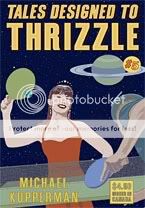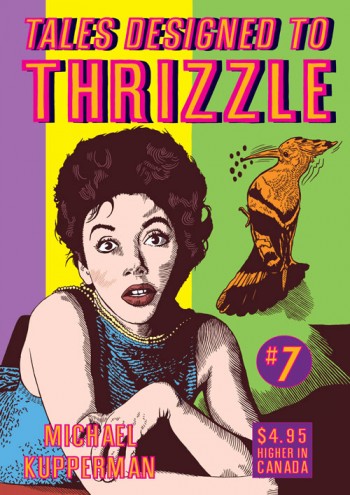Posts Tagged ‘Tales Designed to Thrizzle’
Comics Time: Tales Designed to Thrizzle #7
November 23, 2011Tales Designed to Thrizzle
Michael Kupperman, writer/artist
Fantagraphics, November 2011
32 pages
$4.95
Buy it from Fantagraphics
For today’s Comics Time review, please visit The Comics Journal.
Comics Time: Tales Designed to Thrizzle #5
August 16, 2011 Tales Designed to Thrizzle #5
Tales Designed to Thrizzle #5
Michael Kupperman, writer/artist
Fantagraphics, 2009
32 pages
$4.50
Buy it from Fantagraphics
(Originally posted at this blog’s previous location on May 26, 2009; I am reposting it because it does not seem to have made the move to the current site.)
By now I’ve written about how Kupperman’s humor works at some length, so you’d think it would have occurred to me by now that his humor is an entirely different animal from the vast majority of humor comics. Which it is, insofar as it’s funny and most humor comics aren’t. But it wasn’t until this (ironically) prose-heavy issue that I realized he’s not doing gag comics at all. The only four-panel punchline-driven strip in this entire book, “Ever-Approaching Grandpa,” basically exists to give lie to the notion of the four-panel punchline-driven strip (and is own title). He’s not content with using just the words and the visuals. I think what Kupperman’s doing–with his long, digressive “stories,” with his riffs on old-fashioned comic-book covers, and so on–is using the stuff of comics itself as a locus of the comedy. A grid of panels implies continuity of action, so he uses that to present an increasingly bizarre and disjointed Twain & Einstein adventure with barely any internal cohesion whatsoever. We assume that captions or word balloons will comment on the visuals against which they are juxtaposed, so he creates a how-to arts-and-crafts strip that for no apparent reason is also a brutal noir (“How to Pattern Print with a Potato, Johnny”). We’ve come to accept certain visual cues as meaning a certain thing, so he literalizes them so that they mean something entirely different–a phone in the extreme foreground actually turns out to be a just-plain gigantic phone; a mother’s wagging finger radiates motion lines that turn out to be “super-vibrations.” In his way, Kupperman’s just as concerned with making comics’ formal aspects work for him as Chris Ware. In his way he’s every bit as effective. Goddammit this book is funny.

